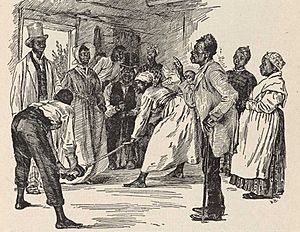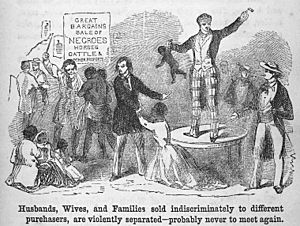Marriage of enslaved people (United States) facts for kids
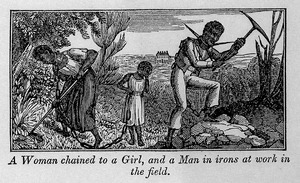
Before the American Civil War (1861–1865), enslaved people in the United States usually could not legally marry. Enslaved African Americans were seen as chattel, which means they were treated like property, not like people with rights. They were denied basic human and civil rights until slavery ended after the Civil War, with the Thirteenth Amendment to the Constitution of the United States. Both state and federal laws either denied or rarely mentioned any rights for enslaved people.
Contents
Laws Controlling Enslaved People
[Slaves] are men, but they must not read the work of God; they have no right to any reward for their labor; no right to their wives; no right to their children; no right to themselves! The law makes them property and affords them no protection, and what are the Christian people of this country doing about it? Nothing at all!
Laws called "slave codes" began in 1705. These laws controlled the lives of African Americans who were enslaved. They were treated like other property, such as farm tools or animals. Enslaved people could not make legal agreements or own any property. Anything they had belonged to their slaveholder. They were not allowed civil or political rights, nor could they decide how to spend their time or where to go. It was even against the law to teach enslaved people to read or write.
In 1856, the Supreme Court ruled in the case of Dred Scott v. Sandford. This ruling said that enslaved people were not citizens and therefore did not have the protection of the Constitution.
However, in some northern states, marriages between enslaved people became legal. For example, in New York, a law passed in 1809 allowed enslaved men and women to marry, and their children were considered legitimate. Tennessee was the only slave state that allowed enslaved people to marry, but only if their owner agreed. Unlike other slave states, Tennessee recognized enslaved people as having some personal status, acting as "agents of their owners."
Relationships Among Enslaved People
Unofficial Marriages
Enslaved men and women formed relationships with each other. They knew that strong relationships were important for their survival. At first, these relationships followed customs from West Africa. There was an expectation of love, care, and loyalty. A "marriage" between enslaved people meant they had chosen an emotional bond and a committed relationship. Being in such a relationship affected a person's standing in their community. It also helped define how black and white communities viewed these relationships. One of the biggest problems with slavery was how it made it hard for families to stay together.
Relationships involving enslaved people were not legally binding. If a couple became free, they might then have their marriage officially recognized. This would make their children legitimate. Clerks were not allowed to give marriage licenses or record these marriages. In some places, ministers were not allowed to perform ceremonies. A long-term relationship between enslaved people was often called a marriage, but it was an unofficial or "quasi-marital" relationship.
Unlike white couples, enslaved people did not have legal protection, church support, or community backing for their marriages. Since they were considered property, they had no legal standing. Their slaveholders made all decisions about their lives. This meant they could not feel secure in their relationships. These unofficial marriages were not supported by the church. This went against Christian teachings about the roles of wives, husbands, and children. The longer a couple and their children stayed together, the more likely they were to be separated. This became especially true after the Act Prohibiting Importation of Slaves in 1808. At the same time, the cotton industry in the Deep South grew, increasing the demand for enslaved people. Meanwhile, tobacco farms in the Upper South switched to crops like wheat and corn, which needed fewer enslaved workers. This led to more enslaved people being sold between states. For example, sugar plantations mainly used enslaved men because the work was so hard. About one-third of first marriages were broken up when partners were sold away due to the domestic slave trade. Relationships also suffered when family members were hired out to other slaveholders for long periods.
Wedding Ceremonies
Within African American communities, couples who formed unions were seen as married. Marriages could be as simple as getting the slaveholder's permission and sharing a cabin. If they exchanged vows, the words had to be changed. The vow "Till death do us part" was changed to allow for separation. For example, it might become "till death or buckra part you," where "buckra" meant "the white man," or "till death or distance do you part."
Sometimes, domestic servants might have formal marriage ceremonies. These were performed by a black plantation preacher or a white minister. After the ceremony, a feast and dance might follow. Such events were rare and more likely for house servants.
Jumping the broom was a special ceremony for enslaved couples. The ways it was done varied. Sometimes, a broom was held about a foot off the ground, and each partner jumped backward over it. Another way was to have two brooms, and each partner jumped over a broom while holding hands. This ritual helped couples feel "more married."
Slaveholder Control
Plantation owners controlled these unofficial marriages. They could decide the future of husbands, wives, and children at any time. They decided if families lived together, if they were sold away from each other, or when they could visit. If couples lived on different plantations, they had a "broad" or "abroad" marriage. Even though they were committed, they were not always allowed to live together. Depending on the distance, they might visit on weekends or stay together nightly. For slaveholders, broad marriages could make it harder to control enslaved people if they became too independent.
Slaveholders might encourage marriages between enslaved men and women on their plantation. A rich owner might buy the spouse of a "broad" marriage so they could live together on their estate. Owners learned that it was often better for their enslaved workers to be married and have families. It meant people might be calmer and less likely to run away.
When a slaveholder allowed a couple to have a relationship, it was often to increase the number of enslaved people they owned. This would make more money for the slaveholder. Enslaved women, whether married or not, were often forced into relationships with their owners. The owners benefited financially by having more children, and they had more control as the biological father.
Historian Eugene Genovese noted that plantation masters understood how important family ties were to enslaved people. He said that plantation records show masters knew this. They often listed enslaved people by households and used family relationships in their rules. Selling a difficult enslaved person might be delayed if it would upset their family members who were good workers. On the other hand, an enslaved person might be sold to break their influence over valuable relatives.
Husbands and Fathers
Some men and women lived with their children in nuclear families. However, in most cases, enslaved fathers did not live with their families. Enslaved couples often took on typical male and female roles in their relationships. But because their children and wives were controlled by slaveholders, men had less control over their families than free men did.
In the 19th century, Alexis de Tocqueville observed that there was a "deep and natural dislike between marriage and slavery." This was because an enslaved man could not be a true authority figure to his wife and children. He could not control their future, their work, or their privileges.
Enslaved men would hunt, fish, and grow crops or raise animals to feed their families. They might also do "overwork" tasks to earn extra things that improved their families' lives.
Children
According to the law (partus sequitur ventrem), children born to an enslaved woman belonged to her slaveholder. In many places, once enslaved people in long-term relationships became free, their marriages were recorded. Their children were then considered legitimate.
She would take me upon her knee and, pointing to the forest trees which were then being stripped of their foliage by the winds of autumn, would say to me, my son, as yonder leaves are stripped from off the trees of the forest, so are the children of the slaves swept away from them by the hands of cruel tyrants; and her voice would tremble with deep emotion, while the tears would find their way down her saddened cheeks. On those occasions she fondly pressed me to her heaving bosom, as if to save me from so dreaded a calamity, or to feast on the enjoyments of maternal feeling while se yet retained possession of her child.
When he was 15, Henry Box Brown was separated from his mother, father, brothers, and sisters after his slaveholder died. He was sent to work at a tobacco factory in Richmond, Virginia. Brown had believed he would be freed when his owner died.
After the Civil War
The Thirteenth Amendment freed enslaved people, meaning they were no longer considered property. The Civil Rights Act of 1866 gave freed people the right to own, sell, or rent property. It also allowed them to make contracts and have basic human rights. They could also marry. After the Civil War, states decided how to recognize long-term couples as married and what rights they had.
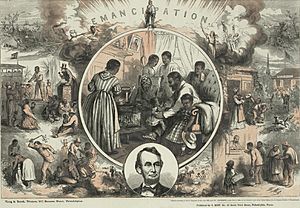
After the Civil War, freed men and women searched for family members they had been separated from. They traveled long distances and contacted many organizations. They followed old slave trade routes, contacted churches, and reached out to the Freedmen's Bureau to find spouses they hadn't seen for years. One of the most important rights freed people chose to use was the right to marry. This led to many African American marriages soon after the war ended. However, a few felt forced to marry by missionaries or worried about unknown obligations.
Major General Oliver Otis Howard was hired by President Andrew Johnson in 1865 to lead the Freedmen's Bureau. This bureau helped with the Reconstruction of the country, especially in former Confederate states. The Bureau worked in camps for former enslaved people. Officers were hired to record former slave marriages. Ministers provided records of marriages they had performed and made other marriages official.
The Bureau recorded marriages and kept records of former enslaved men and women in registers, certificates, and licenses. States and other groups also made long-term relationships official. It's ironic that black people were prevented from legal marriages while enslaved, but then were often punished if they lived together without being married once they were free. Being married became a moral and legal requirement for black people in American society. Some African Americans who had been in unofficial marriages were prosecuted for choosing a different partner to legally marry once they were free, not knowing there would be legal problems.
Notable Couples
Ellen and William Craft
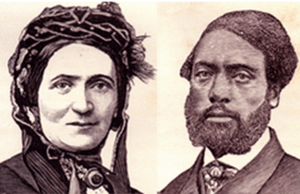
Ellen and William Craft were both born into slavery and separated from their parents when they were young. They cared for each other, but they decided not to marry officially because Ellen didn't want to have a child who would be born into slavery. They planned to escape. Ellen had light skin, like her father, so she dressed as a male slaveholder traveling with William, who pretended to be her enslaved person. They successfully escaped slavery and lived as husband and wife.
Charlotte and Dick Green
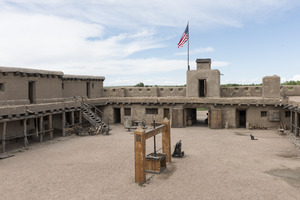
Charlotte and Dick Green were very important to the success of Bent's Fort on the Santa Fe Trail. They remained enslaved until Dick was rewarded for his part in a military group. This group was sent to get revenge for the death of Governor Charles Bent of New Mexico. The Greens were freed by William Bent, Charles's brother, in 1847. They then moved east back to Missouri.
Emeline and Samuel Hawkins
Emeline and Samuel Hawkins, an enslaved woman and a freed sharecropper, considered themselves a married couple. They lived together with their children. Their two oldest children were sold away from the family in 1839. Samuel had tried but failed to buy his wife's freedom. Four more children were threatened to be sold away. With Samuel Burris, Samuel Hawkins planned his family's escape. The family made it to Byberry Township, Pennsylvania, where they changed their last name to Hackett. They were reunited with their oldest sons, Chester and Samuel, who were apprentices in the area.
Sarah Ann and Benjamin Manson
Sarah Ann and Benjamin Manson were an enslaved couple from Wilson County, Tennessee. They had lived as husband and wife since 1843 and had sixteen children. They were legally married on April 19, 1866, and received a marriage certificate from the Freedmen's Bureau. This certificate was a symbol of their right to live together as a family.
Historians' Views
Since the mid-1970s, some historians like Herbert Gutman, John Blassingame, Jacqueline Jones, Ann Malone, and Eugene Genovese have argued that most enslaved children grew up with both parents. However, newer studies and reviews of records in Loudoun County, Virginia, by Brenda E. Stephenson, show that the husband and father had a much smaller role in enslaved families. He often could not be the leader for the family. Often, mothers led the family on plantations and had "abroad" spouses who lived on other plantations. Because of this, an enslaved man might have ongoing relationships with more than one woman. According to Herbert Gutman, a slave record from a South Carolina plantation over nearly 100 years shows that there were long-lasting marriages between enslaved men and women. He found examples of long-term marriages in other states, like Virginia, northern Louisiana, North Carolina, and Alabama.
Families were further separated when black people were sold to the Deep South and Southwest in the years before the American Civil War. When families were split apart, historical records show that black people made great efforts to reunite them. Historians still debate how much slave families were destroyed by the trade of enslaved people between states.


